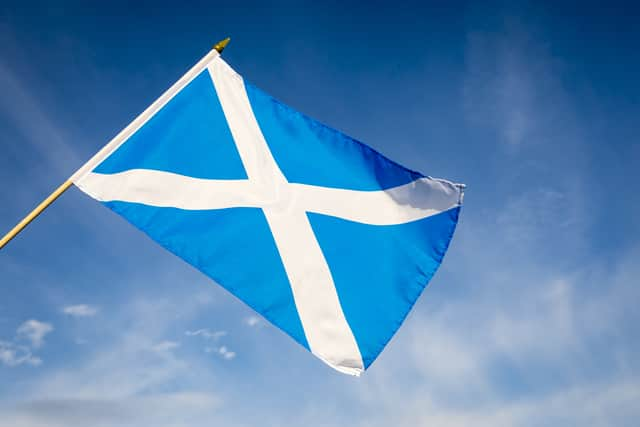Who was St Andrew? Why was he patron saint of Scotland, when was he born, how did he die - and other facts
and live on Freeview channel 276
Scotland is getting ready for St Andrew’s Day - the annual celebration of the country’s patron saint.
Like St George’s Day in England and St David’s Day in Wales, the bank holiday is a celebration of Scottish culture, with the day marked by the appearance of everything from national dishes to the Saltire flag.
Advertisement
Hide AdAdvertisement
Hide AdIt has become steeped in even more significance in recent years owing to the growth in the Scottish independence movement, which seeks to associate itself closely with the imagery and culture associated with the patron saint.
But the reason why the country marks the life and death of St Andrew every year is not widely known, with the Christian’s back-story proving to be a surprising tale that actually has little to do with Northern Europe, let alone Scotland.
So who was St Andrew, what is his connection to the Scottish flag - and when is his life celebrated? Here’s everything you need to know.


When is St Andrew’s Day 2022?
St Andrew’s Day 2022 is set to take place on Wednesday 30 November. It falls on the same date every year.
Advertisement
Hide AdAdvertisement
Hide AdScotland has had St Andrew as its patron saint since 1320, although feasts have been held in his honour since at least 1000 AD.
How to say ‘happy St Andrews Day’ in Scottish Gaelic
If you want to wish a Scottish person who speaks Gaelic a happy St Andrew’s Day, you should say: ‘Latha fèill Anndrais sona dhut’ [Lah-Fail-Andras-Suna-Doit].
If you want to say it to a group of people, the correct way of doing so is: ‘Latha fèill Anndrais sona dhuibh’ [Lah-Fail-Andra-Suna-Yiv].
Both turns of phrase are very literal translations of the phrase.
Who was St Andrew?
Advertisement
Hide AdAdvertisement
Hide AdSurprisingly for a figure of such cultural importance, not much is actually known about who St Andrew was. It’s believed he was born in what is now Israel at some point between 5AD and 10AD.


According to Christianity, he was a fisherman before becoming one of Jesus’s 12 disciples. At some point after Jesus’s death, St Andrew met a grisly end.
The Romans sentenced him to death by crucifixion in Greece. But he is believed to have asked to be crucified on a diagonal cross because he felt he wasn’t worthy of dying on the same-shaped cross as Jesus.
How did St Andrew become Scotland’s patron saint?
Again, the mists of time have obscured the reason why St Andrew was chosen to be the patron saint of Scotland. But we do know that the manner of his crucifixion inspired the country’s flag - the Saltire.
Advertisement
Hide AdAdvertisement
Hide AdThe first time the diagonal cross appeared on a flag was thought to have been at the battle of Athelstaneford in East Lothian in 832AD. Pictish king, Angus mac Fergus, was said to have seen a Saltire appear in the sky immediately before his victory.
It then made its first official appearance as a symbol of Scotland when it was used to authenticate legal documents and communiques in 1286. By 1390, during the reign of King Robert III, St Andrew was starting to appear on coins.
Although he’s the patron saint of Scotland, St Andrew almost certainly never set foot in the country. Despite this, some have claimed in the past that the town of St Andrews is his true final resting place.


Another story has it that relics of the saint were brought to the Kingdom of Fife from Greece in the fourth century by St Regulus, after he was shipwrecked off the coast.
Advertisement
Hide AdAdvertisement
Hide AdBizarrely, for a figure of such cultural importance to Scotland, the country shares St Andrew with several other countries. He is also the patron saint of Romania, Greece, Russia, Ukraine and Poland.
What happens on St Andrew’s Day?
St Andrew’s Day is a public holiday in Scotland. But unlike in the other UK nations, bank holidays are not legal requirements in Scotland and so not everyone gets the day off.
The day often has public events celebrating Scottish culture, usually involving food and drink, music and ceilidh dancing. Traditional food consumed on the day can include the soup dish cullen skink - which is made of smoked haddock - potatoes, onions, and clootie dumpling and custard.
The latter is a dessert made of dried fruit, spices, oatmeal or breadcrumbs, flour, and beef suet. The word ‘clootie’ means ‘cloth’ and describes what the dumpling was traditionally boiled in.
Comment Guidelines
National World encourages reader discussion on our stories. User feedback, insights and back-and-forth exchanges add a rich layer of context to reporting. Please review our Community Guidelines before commenting.
